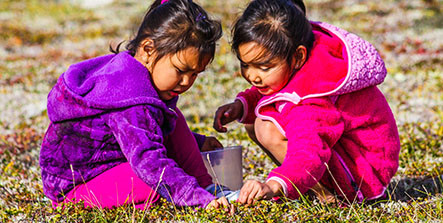In 1969, the Alaska Federation of Natives (AFN) sought a demonstration project to give Alaska Natives greater power in health care decisions. Norton Sound was selected for development of a model for community-based health care services as an alternative to regional, hospital-based care. Norton Sound Health Corporation (NSHC) was incorporated November 27, 1970. The first board had just three directors: William Takak of Shaktoolik, president; Winfred James of Gambell, treasurer; and Dorothy Isabell of Teller, secretary.
That first NSHC Board of Directors faced a formidable task: Bring health care services to a remote area with limited resources. At the time, northwest Alaskans had little access to health care, and getting medical treatment often meant traveling long distances to regional hospitals. One of the first initiatives NSHC launched was the health aide program, established in 1971. While health aides continue to be the backbone of the NSHC organization today, more than 40 years later, NSHC’s services have expanded to include clinic travel clerks, village-based counselors, patient benefit coordinators, dental health therapists and nurse practitioners in all the villages served.
At its first meeting in November 1970, the NSHC Board of Directors established its highest goal: provide a “comprehensive and quality inpatient facility in Nome.” That year, NSHC opened its first office in the basement of Maynard-McDougall Memorial Hospital in Nome, with a budget of $143,000. Six years later, NSHC purchased the hospital, and in 1978 Norton Sound Regional Hospital opened in Nome. It was quickly followed by Unalakleet’s sub-regional health clinic, staffed by a physician assistant and community health aides serving four villages.
In 1975, NSHC became the first Native health corporation to become independent of AFN and contract directly with the Indian Health Service. The following year, the board assumed responsibility for regional environmental health services through assignment of a federal Public Health Service sanitarian.
Over the years, NSHC’s board focused on expanding patient care in the Bering Strait region of Alaska, adding basic services in 15 villages throughout the Norton Sound area as well as specialty clinics in Nome. Areas of specialty care include the Infant Learning Program, Rainbow Services for patients with developmental disabilities, the Injury Prevention Program, WIC, the “Waiting Place” home for expectant mothers and the Chronic Care Active Management and Prevention Program (CAMP), established to focus on lifestyle changes including diabetes prevention and smoking cessation.
The board’s hard work has resulted in milestones such as the purchase and installation of a CT scanner and cancer treatment chair, both of which have reduced the need for NSHC patients to travel to Anchorage for treatment.
In 2008, the Board of Directors adopted the motto “Patient First” to reflect NSHC’s commitment to making quality patient services our highest priority. In October of that year, NSHC opened The Patient Hostel, a 38-bed facility that offers patients a quiet, comfortable place to stay while receiving treatment in Nome. In its first year of operation, more than 1,400 patients lodged at The Patient Hostel.
Another milestone was reached in 2009, when Indian Health Services awarded NSHC full funding to complete a new hospital building in Nome. Construction began in October 2009 and was completed in 2012. The first patients were seen at the new Norton Sound Regional Hospital and Quyanna Care Center in 2013.
Past Board Chairmen
1970-1971 William Takak – Shaktoolik
1971-1974 Charles Degnan – Unalakleet
1974-1975 William Takak – Shaktoolik
1975-1977 Darryl Trigg – Nome
1977-1978 Jack Fuller- Nome
1978-1979 Louise Bockman – Nome
1979-1982 Charles Soxie – Unalakleet
1982-1983 Joseph Dexter- Golovin
1983-1984 Charles Soxie – Unalakleet
1984-1985 Caleb Dotomain – Golovin
1985-1991 John Jemewouk – Elim
1991-1992 Larry Ivanoff – Unalakleet
1992-1995 Joseph Dexter- Golovin
1995-1999 Larry Ivanoff – Unalakleet
1999-2008 Emily Hughes – Teller
2008-2016 Emily Hughes – Region at Large
2016- Jacob Ivanoff – Unalakleet
Timeline
1970
Village Health Services Department formed.
Family Services (mental health) Department formed.
1971
Community Health Aide training begins.
1972
Community Health Aide curriculum developed.
New hospital feasibility study begins.
Paraprofessionals trained to do eye refractions.
Construction begins on eight village-built and –owned clinics; completed in 1974.
Dental Demonstration Project, with financial incentives for prevention, begins.
1973
Indigenous mental health workers trained for villages.
1974
NSHC becomes first Native health organization to hire a full-time physician to deliver direct patient services; second is hired later in year.
1975
NSHC is first Native health corporation to become independent of the Alaska Federation of Natives and contract directly with Indian Health Service.
1976
NSHC assumes responsibility for regional environmental health services (excluding water and sewer construction) through assignment of a federal Public Health Service sanitarian.
Emergency Medical Services department formed.
1977
NSHC purchases Maynard McDougall Memorial Methodist Hospital in Nome.
1978
NSHC builds and opens Norton Sound Regional Hospital.
Unalakleet subregional health clinic, staffed by a physician assistant and several community health aides, and serving four villages, opens.
1979
National Science Foundation funds self-help workshops in region on alcoholism and on water and sewage systems.
1990
Corporate restructuring study and strategic planning implemented.
Psychiatry services available in region for first time.
1991
Norton Sound Regional Hospital earns JCAHO reaccreditation.
First statewide conference on emerging inhalant abuse problem held in Nome.
Prematernal home earns Medicaid certification.
NSHC Native development internship program selects first intern.
1992
NSHC signs first contract with a dentist not from the Public Health Service.
Community Health Education Program founded.
Maternal Child Health program founded.
Telemedicine projects begin, linking health aides to Nome staff.
Snowmachines or 4-wheelers purchased for village clinics.
1993
Alaska Head Start Improvement Initiative pilots project in Nome, leading to annual visits from private dentists to help serve village children.
Computers placed in village clinics.
1994
Quyanna Care Center wins Quality of Life Award from Provider Magazine for activity program, use of Native foods.
Community Health Education Program offers health promotion grants to villages.
1995
First full-time physical therapist hired.
Tuberculosis Outbreak Team formed to help health aides respond to ongoing outbreak in three villages.
NSHC celebrates 25th anniversary.
First dentist hired for Euksavik Clinic in Unalakleet.
1996
Board approves hiring physician assistants for Shishmaref, Gambell and Stebbins.
Little Diomede becomes first area village to contract directly with IHS.
NSHC offers clinic renovation/construction grants.
St. Lawrence Island clinic staff win 1996 Governor’s Alaskan of the Year Award for handling TB outbreak.
NSHC and others enter joint venture to form Inuit Development Diversified, a health-related corporation to generate revenue for the future.
1997
JCAHO re-accredits Norton Sound Regional Hospital.
Village Clinic Standardization Project brings new medical equipment and vehicles.
Tribal doctor program begins.
1998
Behavioral Health Services integrates mental health and substance abuse treatment.
Village Based Counseling Program in all area villages.
5-year Indian Health Service diabetes grant awarded.
Alaska Native Tribal Health Consortium assumes management of IHS Area Office.
First radiologist hired.
Modular offices purchased, programs moved to NSHC campus.
1999
Health aides certified, allowing NSHC to bill Medicaid for some services.
SAMSHA funds mental health and substance abuse services to adolescents and young adults.
Planning continues for greater integration of services.
2001
40 acres of land was purchased for a new hospital in Nome.
2004
A wide-area network was installed, linking village clinics with Nome
New hospital design developed.
2008
The Patient Hostel/Pre-Maternal Home was completed.
The Norton Sound Health Corporation campus became tobacco-free.
2009
The CT scanner was added to improve diagnosis and screening.
Work began on the new hospital.
2012
The new Norton Sound Regional Hospital was completed, and departments began moving in.
2013
First patients seen at new facility, and new Quyanna Care Center opened.
2014
Electronic Health Record system was implemented.


